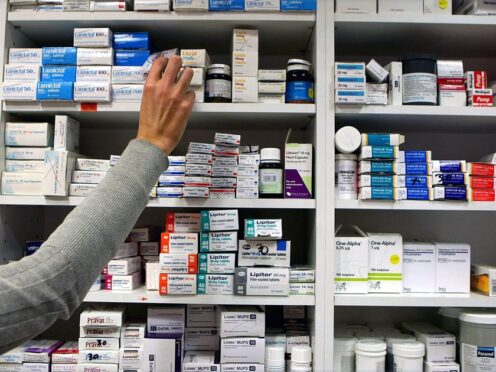
Medicine shortages have increased and are “around double what they were a year ago”, it has been claimed.
Speaking to the Health and Social Care Committee on Monday, Mark Samuels, chief executive of the British Generic Manufacturers Association (BGMA), said they have been highlighting the medicine shortage risk to ministers since July 2021 and the BGMA is “very concerned about it”.
He said: “We’ve been monitoring it for several years now, and as you saw in the written evidence, shortages have increased.
“They’re around double what they were a year ago. We have them at 101 shortages in February this year.”
The shortage of certain medications “continues to be challenging”, Dr Rick Greville, director of distribution and supply at the Association of the British Pharmaceutical Industry (ABPI), told the committee.
But when asked if the shortage is getting better or worse, he said it is “difficult to know as to whether it is increasing significantly, but certainly it’s a long-standing issue”.
Meanwhile, there is “serious concern” about the potential harm to people with diabetes due to a shortage of medication, the committee was told.
It comes after NHS England and the Department of Health and Social Care published a National Patient Safety Alert in relation to a shortage of glucagon-like peptide-1 receptor agonists (GLP-1 RAs) last month.

The range of drugs help manage blood glucose levels in people with type 2 diabetes, but there has been a surge in off-label prescriptions for some to aid weight loss. The alert said supplies are not expected to return to normal “until at least the end of 2024”.
Helen Kirrane, head of policy, campaigns and mobilisation at Diabetes UK, said the shortage of GLP-1 has been having a “huge impact” on people with type 2 diabetes over the last six to eight months.
Asked if people were getting sicker as a result of the shortages, she said it is often only over time that the serious consequences will come to light and there is “serious concern about the harm that could be caused”.
She said: “We’ve just been hearing devastating stories from people about the emotional toll it’s sort of taking on them not being able to access vital medications.
“Not being able to, you know, feel like they can continue, not be able to go to work and to live their daily lives not being able to manage their condition effectively.”
Ms Kirrane said one of the key things Diabetes UK has seen with GLP-1 shortages is a “huge explosion of interest in this type of medication for weight loss globally over the last year or so”.
She added the charity has noted the “huge surge” in off-label prescribing in the private sector.
An estimated one million adults in England are living with undiagnosed type 2 diabetes, according to new figures released by the Office for National Statistics (ONS) on Monday.
Using data from the Health Survey for England 2013 to 2019, the ONS estimates that 7% of people over the age of 16 show evidence of type 2 diabetes, although three in 10, or about one million, were not diagnosed.
On the ONS figures, Ms Kirrane said there is a “real potential for equipping, skilling up, training community pharmacy to understand more about prevention of type two diabetes”, and the care and support signposting could make a “huge difference to people”.
Steve Brine MP, chairman of the committee, said he saw three people in a community pharmacy being told their prescription was not available while waiting 20 minutes as a customer.
He said the options those patients faced were to shop around to try and get prescriptions from alternative pharmacies or to go back to their GP and ask for another prescription for a different medicine for the same condition.
Janet Morrison, chief executive of Community Pharmacy England, said she believes pharmacists should be allowed to make substitutions for alternative appropriate medication or formularies.
One suggestion Mr Samuels made when asked what ministers should do is retaining staff at the Medicines and Healthcare products Regulatory Agency, as there is a “huge backlog” in the licensing of generic medicines.
Dr Greville said that part of the ABPI’s messaging to Government is to ensure that there are “very few disruptions to the movement of medicines around the world”, which he labelled “absolutely critical for maintaining a supply resilience to the UK”.
He added: “It’s the throughput of medicines across borders, which we believe is highly critical to the success here.”

Enjoy the convenience of having The Sunday Post delivered as a digital ePaper straight to your smartphone, tablet or computer.
Subscribe for only £5.49 a month and enjoy all the benefits of the printed paper as a digital replica.
Subscribe